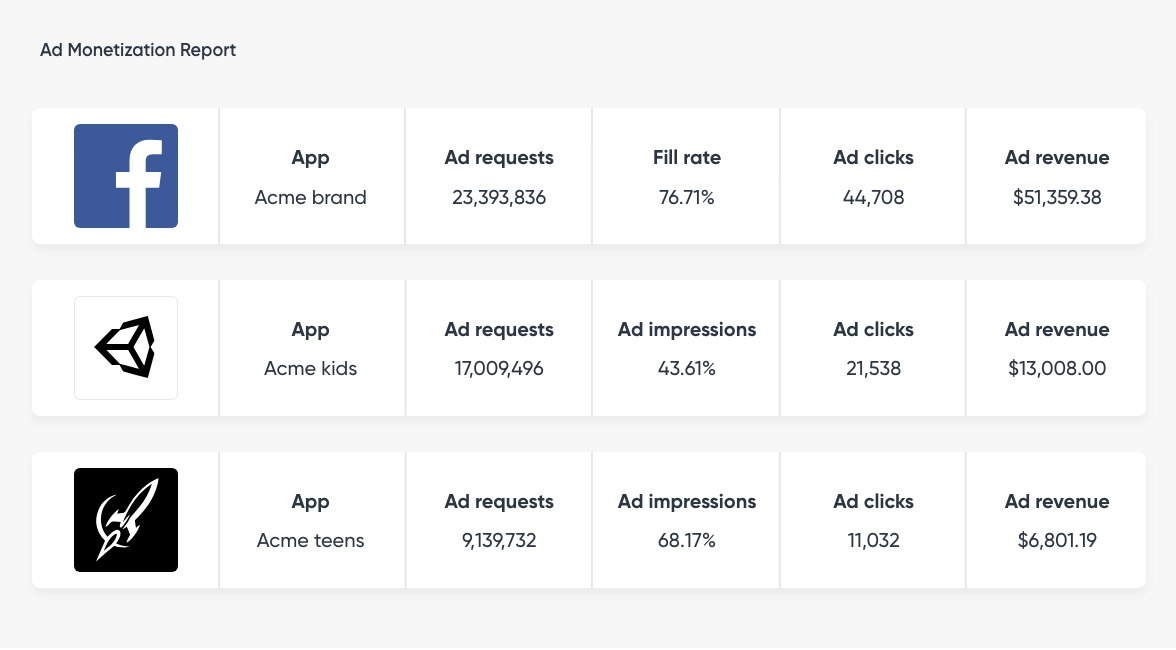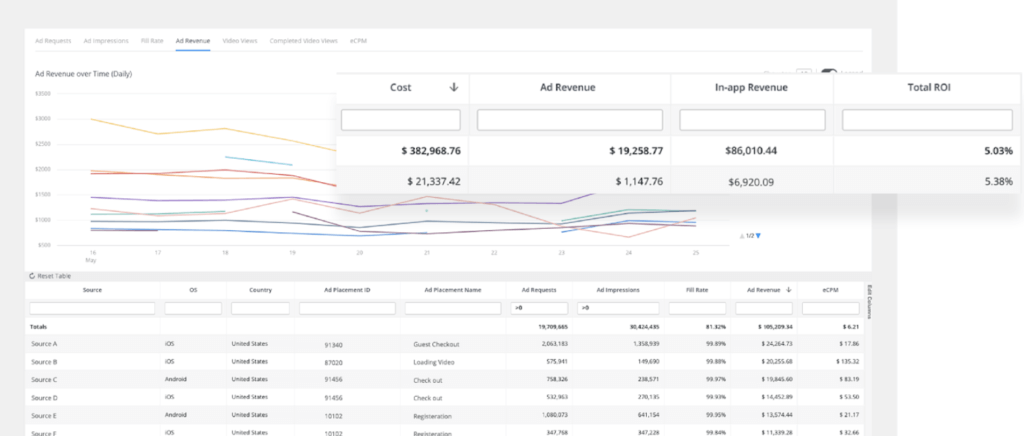Mobile ad monetization: Analyzing true ROI by tying in ad revenue
Can accounting for ad monetization revenue in your user acquisition ROI analysis help your app business grow smarter and faster? According to Singular Product Manager Lisi Gardiner … yes, it can!
It’s not shocking to most in mobile that ad monetization is growing fast. In fact, App Annie says that 60% more apps will build ad monetization into their overall mobile revenue strategies this year. So it’s clear that in-app advertising is a major — and growing — contributor to mobile publishers’ revenue.
For hyper-casual gaming publishers, it could get to 100% of their revenue.
The ad monetization challenge
But there’s a challenge.
When you only drive revenue via in-app purchases, your income is pretty easy to calculate. And so is your ROI on app install ads, because purchases can be connected to users. And, thanks to Singular and other companies like us, users can be connected to where you acquired them from.
But ad revenue is different.

It’s harder to connect granular ad view or ad click information, such as the publisher, line item and payout, to individual users, and consequently to calculate cohorts. It’s harder to total up receipts from mediation platforms, ad networks, and monetization partners. And it’s much harder to connect those revenues with user acquisition costs to make smart, informed decisions about future marketing investments.
Enter Singular’s Ad Monetization Attribution & Analytics.
I spent some time with Singular’s Product Manager for Ad Monetization, Lisi Gardiner, to learn more.
How savvy marketers are figuring it out
Koetsier: Let’s start at the beginning … what percentage of revenue do apps get from advertising?
Gardiner: Easy question, harder answer. Ultimately, it really depends on the vertical and the individual app developer. For each, it’s really about finding the right balance of in-app purchase revenue and ad revenue.
Many app developers will constantly play around with that balance, trying to ensure they don’t show so many ads that it would cause the users to churn.
Hyper-casual games often have between 50-100% of their revenue from ads, and media apps (news apps, lifestyle apps, etc.) might have more ad-focused monetization as well. Other kinds of apps have much lower levels if any at all.
Koetsier: I’m guessing that figuring out the right number of ads is not the only challenge …
Gardiner: Absolutely not. Another key challenge is figuring out the right network fit. Many ad networks focus on gaming apps and gaming consumers, while others cater to other verticals, and you’ve got to find the ones that access consumers — potential users — who fit your app.
Koetsier: So how do most app publishers account for incremental ad ROI? How do they even know how much they’re making from each new user in their apps?
Gardiner: It really depends how sophisticated they want to get and how many resources they have. App developers that have a big percentage of ad revenue have some sort of way to combine the data, but ad networks don’t typically provide transparency on a user-level of how much ad revenue they make, although that is starting to change.
So publishers look at other measurements: sessions, geos, clicks.
But the most important thing to take into account is the business model of how you are getting paid.
If you’re getting paid on a rev-share basis, you’re getting paid for the user to not only view an ad, but click on an ad or complete an install. As an app publisher you ideally want to be selling your traffic on a CPM model, because then it doesn’t matter whether the ad actually works and an app gets installed: you get paid.
And, of course, the more eyeballs you have in your app, the more you’ll get paid.
Koetsier: What about those semi-mythical creatures, ad whales?
Gardiner: Some publishers just want to maximize those eyeballs — any eyeballs. But the other perspective we see is app developers who really only care about ad whales … the 20% of their users who view and/or engage with a lot of ads. And they come up with different flows to maximize ad whales.
Koetsier: What kinds of flows?
Gardiner: As an app developer, I have different places in the game where I can place ads. Like Candy Crush, which I play… if you’re out of lives, you can watch an ad and get a new life. But they’ve also added a different flow. If you’ve lost the game, you can add five more moves by watching a video ad.
So app publishers are testing different placements and formats for the ads.
And, of course, different perspectives: focusing on all users versus focusing on ad whales.
Koetsier: That’s quite a difference.
Gardiner: It is. When I talk to people in the industry, no-one is completely sure they’re doing it the right way. Everyone is asking: what is the best method? They want to know what everyone else is doing, and they want to know what maximizes revenue.
They also want to know: what is the best way to measure ad revenue? Should I measure it via eCPM, or track individual ad whale activity?
Koetsier: How do app publishers typically combine ad revenue with any IAP revenue or other revenue they might have, in order to understand overall ROI?
Gardiner: They’re either doing it manually, or they have a BI team that’s helping them combine it.
Since you’re trying to combine the data on device IDs, that’s a lot of data to be ingesting. Especially for hyper-casual games with small BI teams … that could be really costly in terms of time and money.
Koetsier: I assume you have a better way? Give me a high-level overview of the Singular’s ad monetization solution.
Gardiner: On the highest level, we pull in your user-level in-app purchase revenue and your ad monetization revenue, and then connect it with your cost data so you have a complete view of ROI and ROAS.
Singular gives you four different methods for calculating ad revenue:
- First, the in-house Singular solution
For customers using our attribution, we have a plug and play solution that calculates the average revenue per session and automatically connects it with your user acquisition cost. The result is accurate, cohort-level insights into your ROI which you couldn’t get before because you were missing the ad revenue stream. We’re also able to account for more sophisticated setups that use multiple ad revenue events and more complex calculations. - We also work with Ironsource
We pull in all the user-level revenue data from Ironsource’s mediation platform and then connect it to your cost data. - And we work with MoPub
MoPub offers impression-level revenue data. We receive Mopub events that report revenue data, then cohort it for every device and combine it with ad spend across all of your acquisition sources. - Finally, we work with Soomla
We pull ad revenue data from Soomla and then apply/combine it to your cost data, or any other upper-funnel metric, for comprehensive ROI analytics.

Koetsier: How is this different from competing ad monetization solutions on the market?
Gardiner: First off, Singular is the strongest in pulling and calculating ad spend for every media source you’re working with. That’s in our DNA. We guarantee complete coverage and are not limited to Google and Facebook. That means that ad spend is accounted for in every type of report, at every granularity. You can see the ROI for any aspect of your marketing, whether it’s a channel, campaign or creative. There’s a lot of proven tech around this, which now also applies to our Ad Monetization solutions.
Second, we are integrated with all of the platforms that report user-level and device-level ad revenue. This means that regardless of which vendor you’re working with, we make the best effort to account for every portion of your data.
Third, we are the only MMP that has done the extra work to build comprehensive Ad Monetization Analytics that monetization teams can leverage to grow ad revenue. We want everyone to use Singular and have a single source of truth, and that should not be limited to the UA team. Our Ad Monetization reports can replace your manual reports or reporting vendors, and again uses our tech for pulling data from every type of format with automatic error detection and scalability.
Lastly, we’re flexible. If you want to use a custom ad revenue event, that’s supported. If you’re working with multiple vendors across your app portfolio, we will connect to all of them.
Koetsier: So, let’s say I’m an app publisher. What can I expect if I implement this?
Gardiner: As soon as you implement our SDK and connect your publishers to Singular, ad revenue will be available in every single report we have.
First off, we’re giving you complete visibility into your total ROI, which you never had before. Channels and campaigns that you thought had a specific ROI could look completely different once you factor ad revenue into the ROI calculation. Now you can make better decisions about the actual performance of campaigns and channels.
Plus, we’re going to save you a lot of time. If you’re doing this manually and optimizing just one network every day, we’re easily saving you a couple of hours a day.
Koetsier: And what does that change about how I do my job?
Gardiner: You can optimize your campaigns much more frequently … and you have way better insight into how to do it.
Koetsier: So, bottom line: how does it make me better at growing my app?
Gardiner: We provide a full picture of all your revenue … before you didn’t have a complete view of your revenue.
That means you make better-informed marketing decisions. That means you have what it takes to hit your goals. And, that means you know which media sources provide the most valuable users.
For example, some ad networks might be more expensive, and you might be tempted to cut them, but having ad monetization data from them could indicate that they provide more valuable users, who engage with the ads in your app … so they actually have high ROAS and you should be increasing spend with that network.
At the end of the day: you know more and you’re smarter. So you grow faster.
Koetsier: Thank you for your time!
Want to learn more about tying in ad revenue to your ROI analysis?
Stay up to date on the latest happenings in digital marketing


